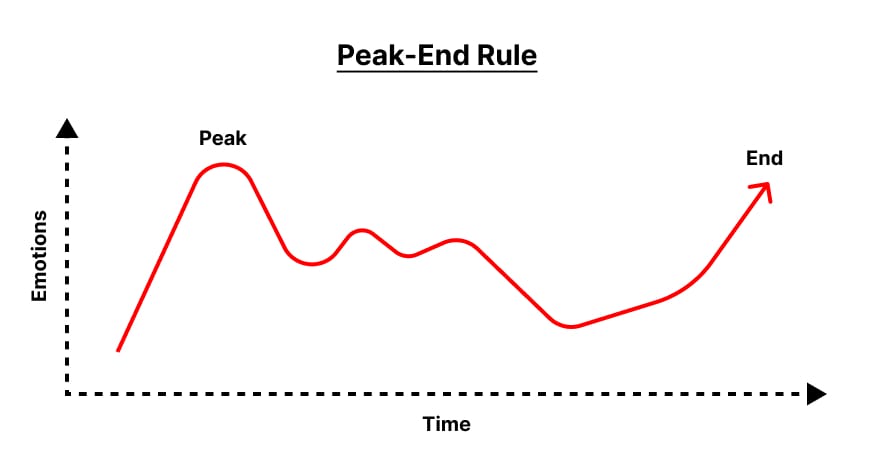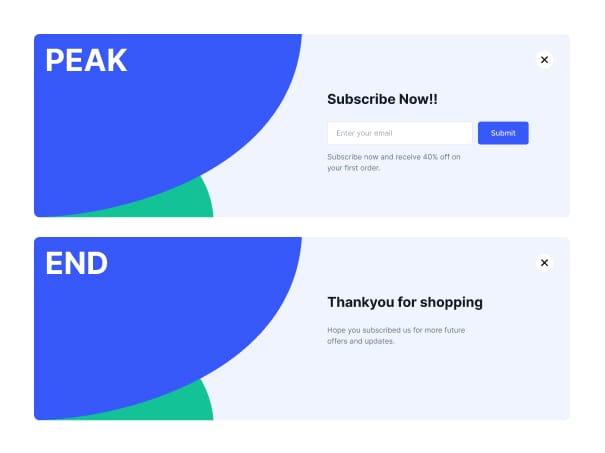Introduction
Within the field of user experience (UX) design, a fascinating idea significantly influences how consumers view and recall their experiences interacting with goods and services. We refer to it as the Peak-End Rule. Perhaps you're wondering what this rule really is and how it affects how digital experiences are designed. Now, let's explore the secrets of the Peak-End Rule and discover how important it is for creating user experiences that people will remember.
What is the Peak-End Rule?
Picture yourself riding a rollercoaster at an amusement park. An excitement rush builds inside you as the coaster reaches its greatest point. Then, when it goes through ups and downs, steep slopes and left-right turns. Your heart rate spikes, causing you to feel both excited and afraid. You exhale in relief as the trip finally comes to a gradual end, filled with a sense of contentment and success.
What do you believe you would recall most clearly from your rollercoaster ride if someone were to question you later? Most likely, you would remember the exciting moments and the satisfying, relieved feeling at the end of the voyage. The Peak-End Rule refers to the tendency for people to recall and evaluate experiences based on their peaks and troughs.
The Peak-End Rule says that rather than the total duration or sum of individual events, our recollections of prior experiences are largely shaped by the strongest (peak) and least intense (end) parts of those experiences.

Understanding the Impact on User Experience Design
How does UX design fit into the Peak-End Rule, then? Let's break it down.
Designing Memorable Moments: Adding high points in the user experience can help users remember you. Peak moments, be they an engaging animation, a satisfying accomplishment, or an unexpected interaction, may produce favourable feelings and improve the user experience. Through thoughtful placement of key moments throughout the user journey, designers may craft unique experiences that users will remember.
Crafting a Positive Ending: The last moments of a user's encounter can greatly influence their overall impression of a product or service. People can feel content and fulfilled when an activity is concluded successfully, a goal is attained, or a personalized message is sent. Designers can make a good impression on people by ensuring the user journey ends smoothly and pleasantly.
Minimizing Negative Peaks: Negative peaks can have the opposite impact, leaving users dissatisfied or frustrated, just as positive peaks can improve the user experience. Users can have a more favourable overall experience and reduce negative peaks by anticipating and proactively addressing potential pain points. Reducing negative peaks is crucial for simplifying complicated processes, giving clear directions, and providing prompt support. Mitigating negative peaks is essential for fostering user satisfaction and loyalty.

Real-World Examples
To demonstrate the usefulness of the Peak-End Rule in UX design, let's look at a few actual examples:
Example 1: Shopping Experience
Consider browsing an online store searching for a fresh pair of shoes. You come onto a product website with gorgeous images, thorough product descriptions, and excellent customer reviews as you look through your selections. You effortlessly finish your transaction by adding the shoes to your cart, checking out, and paying. After the purchase, you get a customized thank-you note and a coupon for your next item. The best parts of this scenario are finding the ideal pair of shoes and making the transaction go smoothly, and the happy conclusion makes you feel appreciated as a client.
Example 2: Fitness App
Now, look at a fitness app that helps users log their exercises and reach their fitness objectives. Users are welcomed with encouraging messages, progress reports, and incentives for hitting goals as they interact with the app. Users receive a congrats message and an overview of their accomplishments after every training session. Users get a growing sense of pride and success as they see their accomplishments represented in the app over time. In this case, the high points come from effective training sessions, and the satisfying conclusion boosts users' self-worth and motivates them to use the app more.
Example 3: Food Delivery App
Let's consider a food delivery app that connects users with their favourite local restaurants for convenient ordering and delivery. Throughout the ordering process, you will appreciate the seamless navigation, clear pricing, and real-time updates on the status of your order. Within minutes, you receive a confirmation notification and an estimated delivery time. As you wait for your meal to arrive, you receive periodic updates on the progress of your order, keeping you informed and engaged.
After your meal, you receive a notification thanking you for choosing the food delivery app and inviting you to rate your experience. Looking back on your experience with the food delivery app, you recall the convenience of browsing and ordering from a diverse selection of restaurants, the anticipation of receiving your order, and the satisfaction of enjoying a delicious meal in the comfort of your own home. The peak moments of browsing and ordering, combined with the positive ending of a satisfying dining experience, leave you with a favourable impression of the food delivery app and encourage you to use it again.

Conclusion
The Peak-End Rule provides insightful information on how consumers view and recall their interactions with digital goods and services. Through the use of high points and satisfying resolutions, Experiences that last with people long after their first interactions can be made by UX designers. Achieving a smooth and satisfying ending, reducing negative peaks, or surprising customers with unexpected shocks are just a few ways that applying the Peak-End Rule's principles can improve the user experience overall and increase user happiness and loyalty.
The Peak-End Rule reminds us that their peaks and valleys frequently determine the most memorable events. This idea can help UX designers create memorable encounters and deep connections with users, resulting in more meaningful and fulfilling user experiences.
So, the next time you're designing a digital experience, remember the power of the Peak-End Rule and strive to create moments that users will cherish and remember fondly. After all, the peak moments and happy endings make life's journey truly memorable.
Thank you for reading this article. Please consider subsribing if you liked this article.
